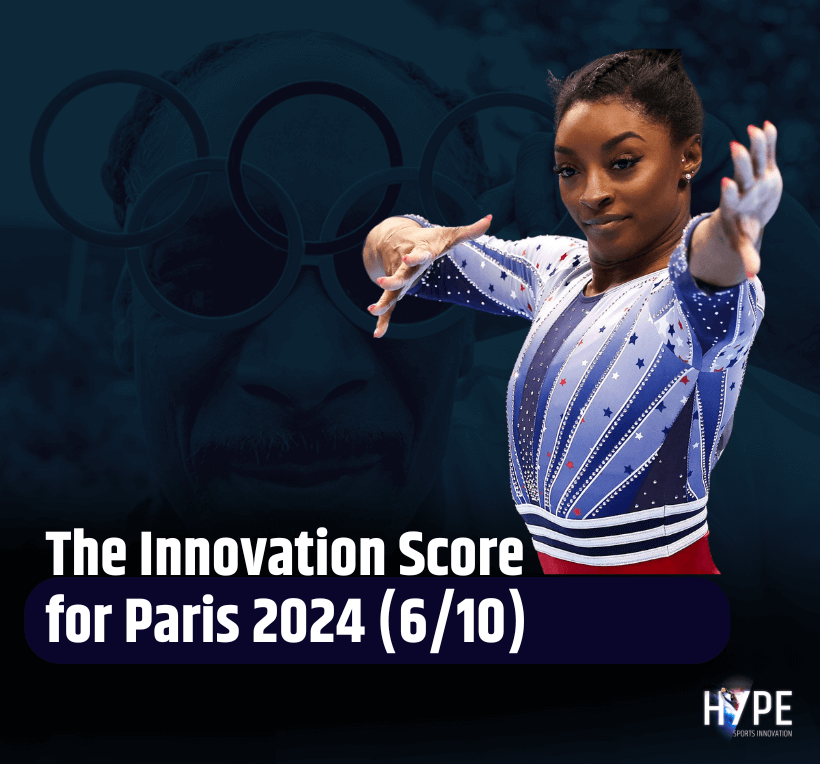

The Innovation Score for Paris 2024 (6/10) – What Fell Short?
3 Min Read
The Innovation Score for Paris 2024 (6/10) – What Fell Short?
What are the crucial lessons for every Sports business leader?
As the dust settles on Paris 2024, it’s evident that innovation significantly enhanced the viewer experience. Yet, the journey to a perfect fan experience is far from complete. Reflecting on Paris’ strengths and shortcomings offers valuable insights for all sports stakeholders, especially for Los Angeles 2028. A more proactive approach to technology integration will be crucial. This blog explores what worked, what didn’t with scores for 10 topics that can help sports properties understand their fans’ expected experiences at home.
The Paris 2024 Innovation Score:
1. AI-Enhanced Broadcast Technologies (8/10)
Success: AI-powered multi-camera replay systems improved the broadcast experience with multiple angles and smoother transitions.
Example: Gymnastics finals viewers enjoyed dynamic replays from various angles, capturing Simone Biles’ intricate routines in stunning detail.
2. AI for Personalization (5/10)
The Gap: Limited use of AI-driven content recommendations.
Opportunity: Leveraging AI to suggest personalized content can keep viewers engaged.
Example: Fans watching swimming events could receive recommendations for similar water sports events like diving or synchronized swimming based on their viewing history.
3. Social Media Engagement (7/10)
The Gap: Social media integration was present but much more could be done to engage younger audiences with behind-the-scenes content.
Opportunity: Hosting live chats and virtual watch parties can foster community engagement.
Example: During women’s soccer, live fan reactions and interactive watch parties could have been highlighted.
4. Real-Time Data and Analytics (6/10)
The Gap: Viewers missed real-time biometric data during events like the 100m sprint.
Opportunity: Integrating performance metrics into broadcasts offers deeper insights.
Example: During Noah Liles’s 100m races, real-time data on his speed and stride length could have been shown.
5. Accessibility Enhancements (5/10)
The Gap: Lack of comprehensive accessibility features in broadcasts.
Opportunity: Ensuring multiple language subtitles and audio descriptions can make the Games more inclusive.
Example: Track and field events could have included subtitles in multiple languages and detailed audio descriptions for visually impaired viewers.
6. Customizable Viewing Options (6/10)
The Gap: Lack of customizable viewing options such as different camera angles or commentator choices.
Opportunity: Allowing viewers to tailor their broadcast preferences can personalize the experience.
Example: During men’s basketball games, viewers could have chosen different camera angles or language commentaries.
7. Immersive Viewing Options (6/10)
The Gap: Immersive integration was notably absent during key events like the opening ceremony.
Opportunity: Immersive experiences can offer fans a front-row virtual seat to the grandeur of the Games, this could increase virtual ticket sales for the opening ceremony.
Example: Fans could have virtually attended the dazzling light show, the boats parade of nations, and even the eiffel tower, feeling as though they were in the ceremony.
8. Second-Screen Experience (7/10)
The Gap: Limited interactive content during events like gymnastics finals.
Opportunity: Apps providing synchronized scores, detailed routines, and athlete stats can enhance engagement.
Example: Although there was an event App. This could have been usd to provide real-time updates and detailed breakdowns of Biles’ performance metrics.
9. Fan-Centric Content Creation (5/10)
The Gap: Limited encouragement for user-generated content during events like surfing.
Opportunity: Featuring fan-created videos and reactions can increase engagement.
Example: During surfing events, user-generated videos of fans’ reactions to key moments could have been featured in the broadcasts.
10. Enhanced Connectivity and Coverage (6/10)
The Gap: Streaming issues during high-demand events.
Opportunity: Strengthening streaming infrastructure can ensure a seamless viewing experience.
Example: Buffering issues during high-demand swimming events could be mitigated with improved streaming technology.
The Overall Score: 6/10
In Paris 2024, it became evident that the full potential of available technologies was not fully harnessed, particularly in the realms of biometrics and AI personalization. This oversight resulted in a missed opportunity to create a truly unforgettable, immersive experience. If you don’t bring the fans closer with personalized engagement, they’ll distance themselves from what you’re creating, and that’s a major lesson for any sports property.
Lessons Looking Ahead To LA Olympics 2028
By learning from the strengths and addressing the gaps identified, Los Angeles 2028 can set a new standard for Olympic broadcasting. Enhancing AI personalization, improving second-screen experiences, integrating real-time data, offering customizable viewing options, deepening social media integration, embracing VR and AR, ensuring accessibility, and strengthening connectivity are crucial steps towards this goal.
The future of Olympic broadcasting is bright. With a more proactive approach, LA 2028 can deliver an unforgettable viewing experience for fans worldwide. The key is to continuously innovate, adapt, and prioritize the fan experience at home, ensuring that every moment is not just watchable but truly immersive and engaging.
With love for sports and Innovation,
Amir Raveh HYPE S.I
We help over 100 Sports Properties navigate these challenges.
For more sportsTech Insights, download the Ultimate Guide, with 24 real case studies (10 AI ones!) and a proven roadmap to help you increase ROI and reduce costs [Click Here to Get Your Free Copy].
*All observations and reviews mentioned here are based on the broadcaster that aired the competition I watched. It’s possible that other broadcasters in different regions provided varying experiences.




Comments